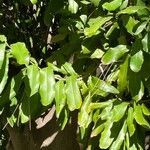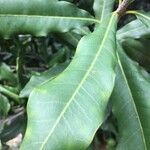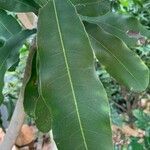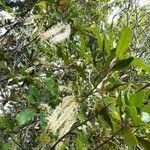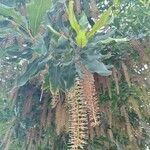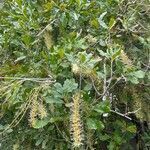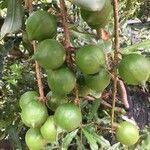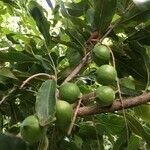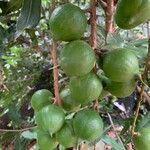Tree, 6-18 m high. Leaves in whorls of 3; lamina ovate to obovate, 65-140 x 20-65 mm, glossy above, paler below, stiffly coriaceous, glabrescent, base very shortly attenuate, apex acute to obtuse, tip rounded, ± mucronate, margins weakly undulate, entire to spinose; midrib prominent below; petioles 6-18 mm long. Inflorescence: rachis 85-250 mm long with flowers in regular, sessile or shortly pedicellate pairs. Tepals 5-10 mm long, cream-coloured. Filaments up to 7 mm long. Anthers 0.7-2.2 mm long. Ovary up to 2 mm long; style up to 11 mm long, tip swollen, functioning as pollen presenter. Fruit a globose follicle, 30-40 x 20-45 mm; pericarp leathery, up to 6 mm thick.
A medium size evergreen tree. It grows 18 m tall and spreads 15 m wide. It has a bushy habit. Young growth is pale green. Young leaves are long and toothed at the edge. Leaves are 10-20 cm long by 3-5 cm wide. They occur in whorls or rings of 3 or 4 leaves. They are stiff and dark green. The leaves are entire with a wavy or slightly prickly edge. Flowers occur in clustered stalks 10-30 cm long. They occur in the axils of leaves and hang downwards. The flowers are about 1.2 cm long. They are slender and white. The fruit are 3-4 cm across and green and leathery. The nuts are produced in a hanging cluster. They are 2-3 cm across and round. They are smooth and shiny.
Trees 5-18 m tall. Leaves mostly in whorls of 3; petiole 4-18 mm; leaf blade oblong to oblanceolate, 5-15 × 2-6.5 cm, leathery, base attenuate, margin irregularly spiny toothed or entire, apex acute to obtuse and sometimes retuse. Inflorescences axillary, simple, 8.5-25 cm, sparingly puberulous; bracts of flower pairs ovate, 0.5-5 mm. Pedicel 3-4 mm. Perianth white or yellowish, 5-11 mm, pilose. Anthers 0.7-2.2 mm. Ovary and base of style brownish villous. Fruit globose, 2-4.5 cm in diam.; pericarp 2-6 mm thick. Seed usually 1, testa bony, smooth. Fl. Apr-May, fr. Jul-Aug.
